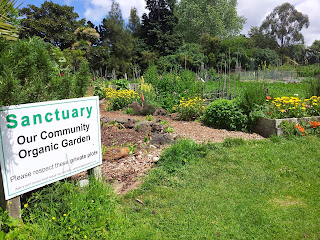When we women in the Mackay family decided to de-commercialise Christmas and make home made gifts my Mum was stuck on just what to give my brothers. Then she remembered how much they loved her raspberry jam so out came the retired preserving pan. She made them a six pack each and my brothers would be slightly dissappointed if their gift every year wasn't raspberry jam.
 |
| Photographs of raspberry jam production by Lynn Dunn, beside the southern Christmas Tree, the Pohutakawa, no doubt grown in their Ribbonwood Nursery, Dunedin. |
My Mum Claire and Lynn's Mum Coline were first cousins and life long friends so naturally they visited each other whenever they could. Lynn and sister Heather were our city cousins and we their country cousins. They would enjoy the freedom of life on the farm and we would love the experience of city life.
 |
| From left to righty: Heather, Me holding my brother Jamie, Lynn and my sister Kerry in the backyard at our farm in Riversdale. |
"I always like to make this jam at Christmas time as the new season's berries are just becoming available. We often take a drive out to McArthurs on the Taieri Plain to buy their delicious local raspberries. It's a good excuse too, to pick up a fresh fruit icecream - another of our family traditions!
It's such an easy jam to make as it only requires a short cooking time and is self-setting - no setting agents needed. Fresh raspberries seem to deliver a better flavour and a glossier appearance.
This traditional recipe simply uses equal weights of berries and sugar.
The fruit is cooked on a low heat for a few minutes until the berry structure has started to break down. The heat is then turned up and the sugar added slowly while maintaining a good boil.
After 3 or 4 minutes I test the consistency by putting a bit onto a cold saucer and then remove from the heat as soon as it forms a slight skin.
We prefer the jam to be a bit runny and not too stiff.
Pour into sterilised jars and seal. It takes a couple of days to set fully."
Thank you Lynn.
I can remember the excitement when the local store called to say the raspberry order had arrived from Central Otago. Mum would get the raspberries in a large tin pail. We knew that night we would be eating lots of raspberries sprinkled with icing sugar and accompanied by a scoop of vanilla ice cream. Some of the raspberries would go into the freezer but the rest was used to make the year's supply of raspberry jam. I don't remember what happened to the tin pails but I'd like to think they were returned to the growers as it was a time before throw away packaging.
 |
| Coline (left) and Claire (right) the best of friends and its thanks to our dear Mums that gifts of raspberry jam have become a tradition at Christmas |
I am more of a marmalade and jelly maker from fruit I get for next to nothing or for free. Lynn tells me that for 2 kilos of raspberries costing $18.50 she can make 10 jars of raspberry jam.
If you haven't the desire to make your own jam or don't have a jam maker in the family, then the next best thing is to buy a good quality jam. My favourites are Butlers Berries Raspberry and Redcurrant jam from Waimate, South Canterbury and Te Horo Raspberry jam from Otaki just north of Wellington.
If you haven't the desire to make your own jam or don't have a jam maker in the family, then the next best thing is to buy a good quality jam. My favourites are Butlers Berries Raspberry and Redcurrant jam from Waimate, South Canterbury and Te Horo Raspberry jam from Otaki just north of Wellington.
Humidity is not at all kind to jam makers. You need a clear sunny day. I am inspired by Lynn's raspberry jam recipe to give it a go while in sunny Hawkes Bay over the Christmas break. Close to good supplies of fresh raspberries and the clear air will be perfect for making jam.
Sadly, jam has far too much sugar to be a health food. But you can eat as many fresh raspberries as you like... in fact gorge yourself on raspberries to lose weight (minus the cream mind). There are many health benefits of this low calorie highly nutritious fruit. Native Americans recognised the importance of berry fruit in their diet and used raspberries to remove tartar from their teeth.
Raspberry can relieve morning sickness and if the tea is regularly consumed an easier labour could be on the cards. If a baby is on the way in your circle of friends and family, I would recommend Artemis Pregnancy Tea that contains raspberry leaf and other herbs good for pregnancy. Sandra Claire from Artemis learnt the secrets of the beneficial plants from a Catholic nun who looked after young pregnant women in the Swiss mountains. In Switzerland she tells me every pregnant woman gets a free prescription of this herbal tea to build uterine strength.
The only problem with raspberries is that they don't keep as long as other berries. How to Store Raspberries gives you some really good tips on how to make them last which could be helpful for those buying berries ahead of time for Christmas Day.
 |
| Berries collected from my sister Kerry's garden set against one of her many nativity scenes around the cottage |
For my readers in the southern hemisphere here's wishing you all a very merry berry Christmas.
And for those in the northern hemisphere, perhaps you can recall the flavour of summer berries through a jar of raspberry jam. Merry Christmas and happy holidays wherever you may be.



























































